Home »
Misc »
How to paint basketball lines on asphalt
How to paint basketball lines on asphalt
How to Paint a Basketball Court
Most hoop lovers are content with a full court to play in, but most will agree that it’s a different feeling when you play in a good-looking court. Not only will it prolong your sneakers’ life span, paint and design on a basketball can inspire spirit and pride. What’s more, it also boosts teams’ morale, and for designs inherent to a community, it does give your place an identity. This article will provide you with tips and tricks on how to paint a basketball court and more.
What Materials are Used to Paint a Basketball Court?Both indoor and outdoor basketball courts are subject to a lot of wear and tear. So at some point, you will have to replace or redesign how the floor looks. For wooden floors or wood tiles used in outdoor gyms, you won’t need to replace them as often. The same cannot be said, though, about outdoor courts.
Outdoor basketball courts are subjected to heat, rain, snow, and everything in between. In extreme conditions, paint should be reapplied every couple of months or so.![]() Most experts recommend acrylic paint to finish an outdoor basketball court. What are some of the reasons acrylic is the best type of paint to use for basketball courts?
Most experts recommend acrylic paint to finish an outdoor basketball court. What are some of the reasons acrylic is the best type of paint to use for basketball courts?
Perhaps the most important reason is that acrylic is made with specially-graded silica sand that prevents slippage. A slippery basketball court because of poor choices in the type of paint can be perilous and may cause injuries. Applying acrylic paint court surfaces make them aesthetically very pleasing while being easy to construct and maintain. Additionally, acrylic paint is resistant to common chemicals.
For other materials to paint a basketball court, you will need rollers (4 inches and 9 inches), pads, and trays. You may also need assorted art brushes, paint can opener, latex gloves, paint cups, duct tape, painter’s tape, and caution tape. During the project, you may need a water hose, pencil or chalk, and measuring tape.
What Kind of Paint Do You Use on a Basketball Court?As pointed out earlier, the most recommended type of paint for outdoor basketball courts is acrylic.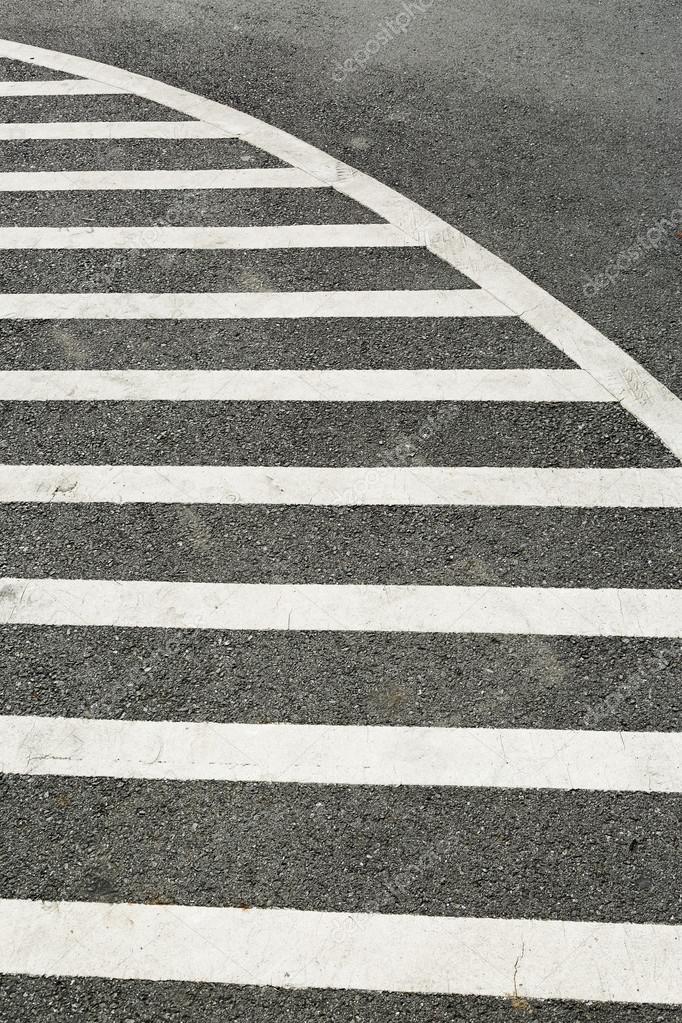 Acrylic has some properties that make it best for traction while adding to the basketball floor’s aesthetic value. What’s more, acrylic is essentially fade-resistant, easy to repair, waterproof, and highly durable.
Acrylic has some properties that make it best for traction while adding to the basketball floor’s aesthetic value. What’s more, acrylic is essentially fade-resistant, easy to repair, waterproof, and highly durable.
Now, there are other kinds of paint that you may use on a basketball court. Some may suggest rubberized paint for concrete basketball courts or perhaps epoxy paint. Generally, both rubberized and epoxy paint are considerably more expensive than acrylic paint, so the latter is more popular as paint used in a basketball court.
How Do You Paint a Three-point Line on a Basketball Court?Marking and painting the three-point line is one of the more difficult paint jobs you can do on the basketball court. The three-point line is long and shaped like an arc, so it’s easy to mess up if you don’t know how to go about with it.
The first thing that you need to do is look up the dimensions of the three-point line. It would be up to you to adopt the regulation distance of the three-point line, whether the high-school, college, or pro dimensions.
After determining the dimensions, the next thing you need to do is to create a makeshift compass. One method of doing it, and perhaps the easiest, is grabbing a string. One end should be at the bottom of the basket and have someone hold the other end with chalk. Drag the chalk with the string across to mark the three-point line. You can paint the line with acrylic paint by merely following the chalk lines.
In the NBA, the three-point line does not have the same distance all around. If you want to simulate an NBA three-point line’s appearance, it will be a little bit more complicated than just tracing an arc from one corner to the other.
What is the Best Surface for Outdoor Basketball Court?If we are talking about outdoor basketball courts, two surfaces are preferred– concrete and asphalt. Other options for the base material for an outdoor basketball court are crushed stone and modular bases. With that being said, most outdoor basketball courts are either concrete and asphalt.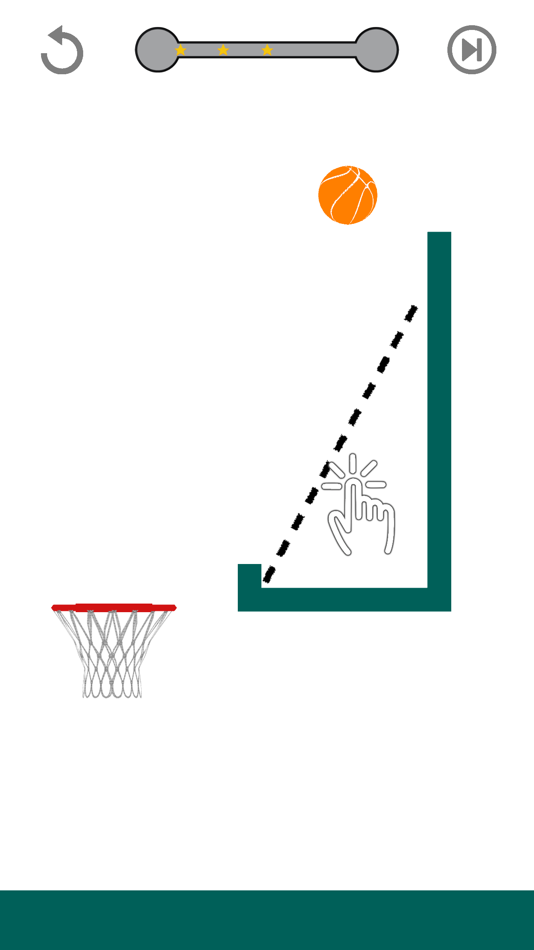
Honestly, it would boil down to personal preference in choosing between the two. In most cases, concrete is the better choice if you consider the cost of maintenance and repair. When done right, a concrete base material for a basketball court is basically maintenance-free. On the other hand, asphalt will deteriorate over time considering the freeze/that cycles, but unlike concrete, it is less likely to sustain cracks.
Now, how do you decide whether to go for concrete or asphalt? It depends on several factors. Relatively, both concrete and asphalt are incredibly strong surfaces, with the former potentially lasting 40 years with proper care and the latter for around 15-20 years. Other factors that contribute to the durability are proper application, thickness, and supporting materials.
As for appearance and functionality, asphalt provides an even surface than concrete. It would also be easier for the joints since it is not as hard as concrete. On the other hand, concrete is essentially non-slip. As we have pointed out, deciding which one is better comes down to personal preference.
As we have pointed out, deciding which one is better comes down to personal preference.
As it stands, whether you choose to have a concrete or asphalt base material or surface, both will require upkeep to lengthen its service years. Resurfacing the material at least once a year may help prevent holes and cracks from developing, thereby lessening the risk for injuries. Sealcoating will also help the weather or rough play from ruining the surface, and applying sealant provide moisture resistance, reducing the need for repairs in the long run.
Here is a rundown of the differences between a concrete and an asphalt surface basketball court:
- Asphalt is the cheaper option than concrete.
- Concrete is more challenging to install than asphalt.
- Asphalt does not last as long as concrete, more so if it’s not correctly built and installed.
- An asphalt surface is more even and softer than concrete, which makes it easier for the joints.
- Post-tension concrete basketball courts are a type of concrete that adjusts to tension to prevent cracks.
 While that is way more expensive, it may be one of the smartest choices as an outdoor basketball court surface.
While that is way more expensive, it may be one of the smartest choices as an outdoor basketball court surface.
Additionally, there is a considerable difference in using premium acrylic paint and its standard counterparts. The standard acrylic paint typically has a 1-year warranty while the premium has up to five years. However, the most significant difference is that the premium acrylic paint has a life expectancy of up to 30 years compared to the standard’s five years.
What’s the Average Cost to Paint a Basketball Court?Like any construction project, the cost of painting a basketball court depends on several factors. Naturally, the bigger the court is, the more expensive the project. How much does it cost to paint a basketball court? A generous estimate, which means at the low end of the spectrum, may cost around $16,000, including the installation of the hoop.
However, not many of us can afford to hire a contractor to do the work. That is why when you consider how much it costs to paint a basketball court, it would be better off to do it yourself than hire someone to do it for you.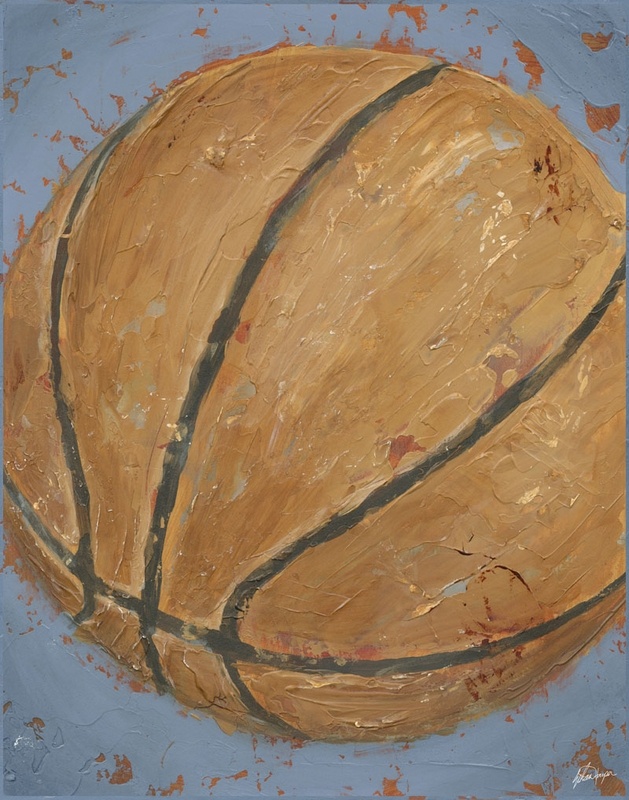
If you or the community already have a basketball court in place, you will save a lot of money doing the project yourselves. At most, you will only need to buy $100 worth of top-notch acrylic paint, or even as low as $50 for acrylic paints with lesser quality. There will be other expenses thrown here or there (like tapes and markers), but that still dwarfs the cost of hiring a contractor to do the job.
5 Tips on How to Paint a Basketball Court1. To ensure that the entire project goes smoothly, pay attention to smaller details such as the materials and how you want the court to look. Sort the materials, piling them by how similar the items are. If you can, make a diagram to follow the pattern that you’d like as to the appearance of the basketball court.
2. Before applying the primer, make sure you wash the whole basketball court clean with a power washer and a broom. If you don’t have access to a power washer, a hose with a powered nozzle will do. Broom the court afterward to make sure it is clean and let the surface dry completely. Drying time may vary depending on the temperature and humidity. This is not the time to be impatient.
Drying time may vary depending on the temperature and humidity. This is not the time to be impatient.
3. After the area dries completely, apply a clear primer to the surface. Use rollers to do this.
4. If you want to take it to the next level and paint some center court logo design, we recommend making a stencil out of poster board. Trace the outline over the poster board and cut out certain sections. Another method uses the grid system where you use the grid or squares as a guide for sketching the image. This is not for everyone, but if you have an artist in your midst, it’s worth a try.
5. Paint the lane in a different color than the lines to add that authentic look and feel. And remember, basketball lines are approximately two inches wide, so don’t vary the sideline, baseline, and centerline width.
Wrapping Things Up: How to Paint a Basketball CourtBasketball courts, whether indoor or outdoor, need retouching and a repaint every once in a while.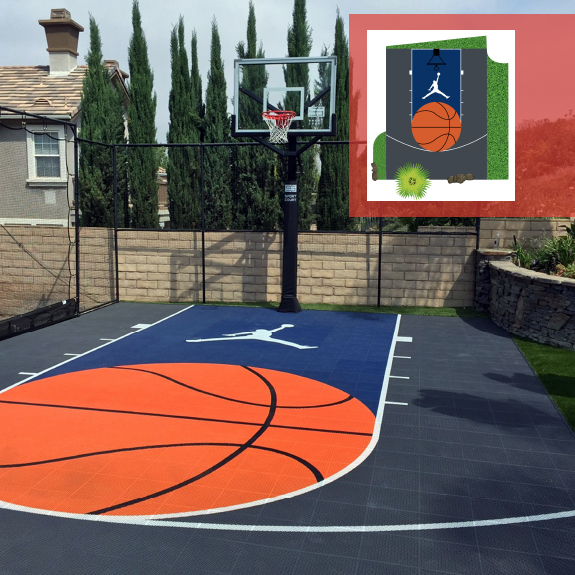 For outdoor basketball courts, repainting may come more often than the elections since these courts are subject to harsh weather.
For outdoor basketball courts, repainting may come more often than the elections since these courts are subject to harsh weather.
The most recommended type of paint for outdoor basketball courts is acrylic. Acrylic paint is made with specially-graded silica that essentially makes it slippage-free. It is also excellent to look at and is available in dozens of colors. Moreover, acrylic paint is resistant to common chemicals.
Acrylic paint is available in standard and premium variants. Standard acrylic paints cost less, but the premium alternative may be the smarter choice in the long run. It has a more extended warranty (five years compared to one) and typically outlasts its standard counterpart in terms of life expectancy (30 yrs to five yrs).
Now, when you’re given a choice between asphalt and concrete as base material or surface in an outdoor basketball court, which should you choose? Most experts would recommend concrete and rightly so.
Concrete is generally more durable and virtually a non-slip surface.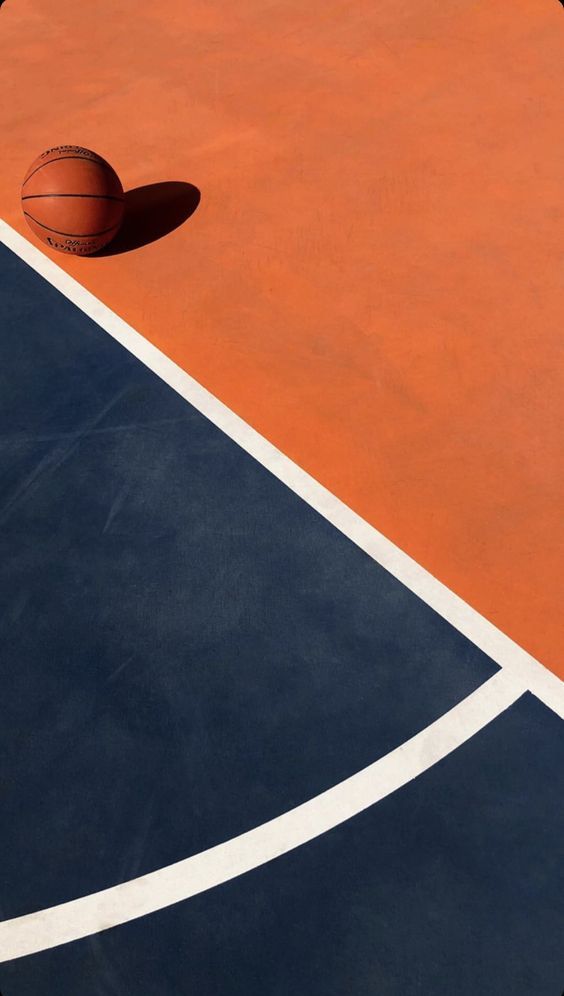 Asphalt has a more bouncy feel and typically costs less to install. However, concrete trumps asphalt when it comes to years of service because some well-built concrete surfaces may last as long as 30 years. Post-tension concrete is an even better, albeit expensive choice. This type of concrete surface “adjusts” to any tension to prevent cracks. It is definitely a smart choice, considering the amount of money you would save in the long haul.
Asphalt has a more bouncy feel and typically costs less to install. However, concrete trumps asphalt when it comes to years of service because some well-built concrete surfaces may last as long as 30 years. Post-tension concrete is an even better, albeit expensive choice. This type of concrete surface “adjusts” to any tension to prevent cracks. It is definitely a smart choice, considering the amount of money you would save in the long haul.
Well, if you had no idea how to paint a basketball court, we hope that this article pointed you in the right direction. Sometimes, these kinds of projects are not to be taken too seriously. If done with friends and the people in your community that care and love basketball, it is definitely an excellent way to build camaraderie while having fun doing manual work.
If you found this post helpful, you’re definitely going to like our other basketball FAQ articles here.
More interesting basketball FAQ posts here:
> How Many Laps Around a Basketball Court is a Mile?
> How Many Yards is a Basketball Court?
> How to Install a Ground Basketball Hoop?
> How Many Square Feet is a Basketball Court?
What to know about Outdoor Basketball Court Painting
A basketball court has to be lined properly in order to ensure the game is played properly.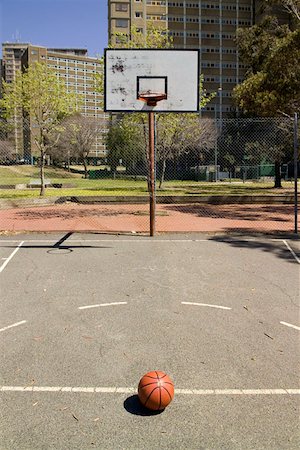 Any issue with the lining of the court could cause problems during play. Basically, accuracy is everything and the paint needs to be easily seen on the surface.
Any issue with the lining of the court could cause problems during play. Basically, accuracy is everything and the paint needs to be easily seen on the surface.
When dealing with outdoor courts, there are normally two surfaces that are worked with. They are the asphalt basketball court and the concrete basketball court. Both surfaces require specific processes when preparing them and actually resurfacing and painting them so that they are once again safe and usable.
Court Resurfacing
Sometimes basketball court resurfacing is needed before any painting takes place. Older courts most likely have cracks and chips in them. The surface could also be crumbling in some places, which can present a hazard. Sometimes what is needed are repairs and other times the entire surface may need to be replaced with asphalt or concrete. Whatever the need, it can be done. Nonetheless, you can count on basketball court resurfacing taking place before the surface is ever replaced. This is a good way to make the surface pay for itself again and again throughout the years – you get the most life out of it as possible.
This is a good way to make the surface pay for itself again and again throughout the years – you get the most life out of it as possible.
Asphalt Basketball Court Painting
Once an existing asphalt paid is repaired and sealed, the necessary wait time has to occur before it is painted. If a new asphalt pad had to be laid, it takes approximately two to four weeks for the asphalt to cure. Basically, you are waiting on the asphalt to completely harden and for the oils to come out of it. If a sports court painting company tried to do asphalt basketball court painting before this period is up, then the paint may not take well due to the oils coming out of the surface.
An acrylic resurfacing paint can then be applied by hand with a rubber squeegee so that the pores in the asphalt are smoothed out. This is what gives the court the smooth finish like a tennis court in many cases. If the court is a traditional asphalt court, then two coats of the resurfacing paint will be needed to give it a smoother feel.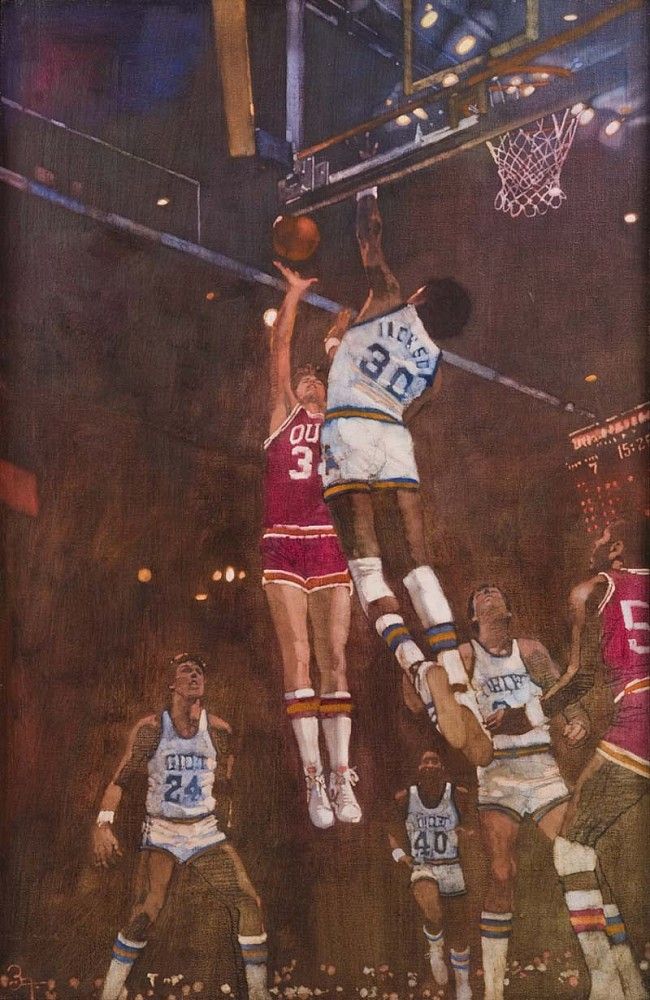
Once the resurfacing coat is down, color can be applied. Two coats tend to do the job. After this coat is dried, then the lines can be applied with a professional taping machine.
Concrete Basketball Court Painting
Just like asphalt, a concrete pad may already exist or a new one needs to be laid. If a new one has to be laid, then it takes two to four weeks for the concrete to cure. When a new one is constructed, it is important for a brush finish to be used. This is very important because the court’s surface has to have texture so the paint has something to hold on to. If it is a smooth finish, then the paint could peel or chip.
Nonetheless, the first step before concrete basketball court painting is to clean the surface so that alkaline can be removed from the surface. An adhesion promoter may also be added so that the first coat of paint is able to adhere properly. One to two coats of an acrylic resurfacing paint is then applied by hand with a rubber squeegee.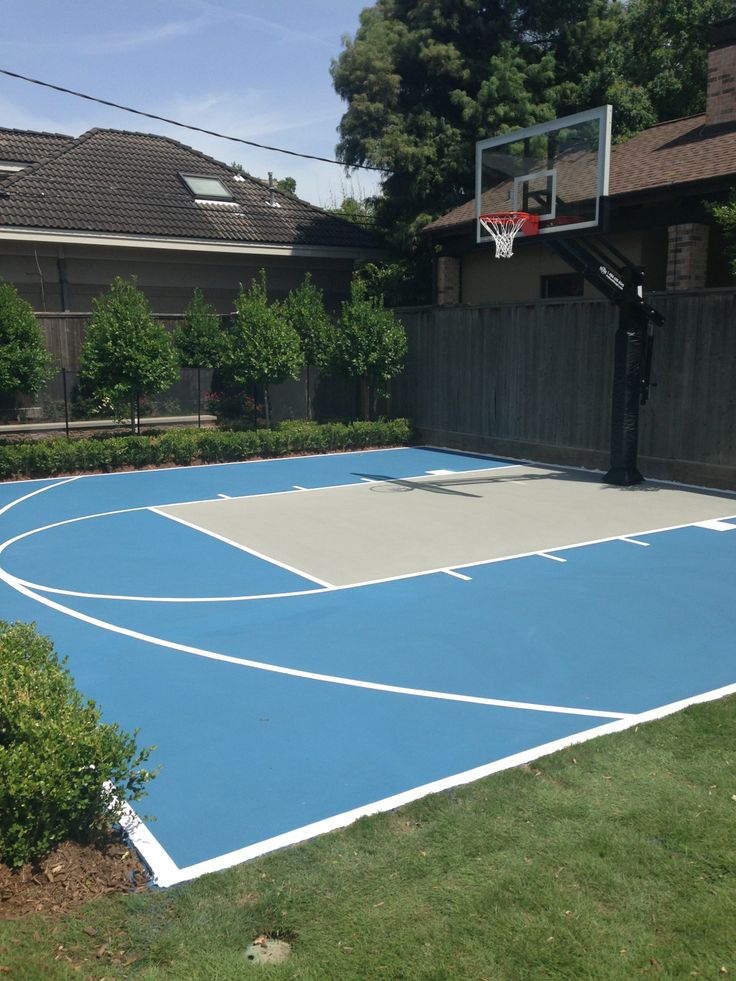 Not as much paint is needed on a concrete court as an asphalt court because concrete is not nearly as porous. But even with less paint needing to be used, four coats of paint should be applied.
Not as much paint is needed on a concrete court as an asphalt court because concrete is not nearly as porous. But even with less paint needing to be used, four coats of paint should be applied.
After this, the color can be applied. Once this phase is complete, the lines can be applied using the professional tapping machine.
You Have a Choice
When you engage a sports court painting company to redo your outdoor basketball court, there are many options that are made available to you. Those options include different colors to choose from, as well as certain designs that can be applied. If the court is an outdoor court belonging to an organization, you can have the organization colors applied along with any logos. It is best to consult with the company to see what your options are and combine your ideas with their creativity to have a basketball court that looks fantastic.
If you have an outdoor basketball court needing painted, Brite Line Paint Co. can help you. Call us at 508-678-6775 or fill out our contact form.
can help you. Call us at 508-678-6775 or fill out our contact form.
Basketball court markings: standards and norms
Author of the article
Khvatkov Dmitry
Consultant in the production of rubber coatings
Basketball field marking requirements are approved by the FIBA standard. The site must be flat with a hard surface, free of bends, cracks and other obstacles. The accepted dimensions of the field are 28 m long and 16 m wide. By NBA standards, the field is slightly larger: 28.7 m (94' ft) long and 15.3 m (50' ft) wide.
Areas not intended for international competitions may differ from accepted standards (for public use, in schools or universities, etc.) and usually vary from 20 to 28 m in length and from 12 to 16 m in width.
Basketball Court Marking Standards
Basketball court markings are conventionally divided into 5 components:
- Boundary lines. They are located along the perimeter of the site and set its size.
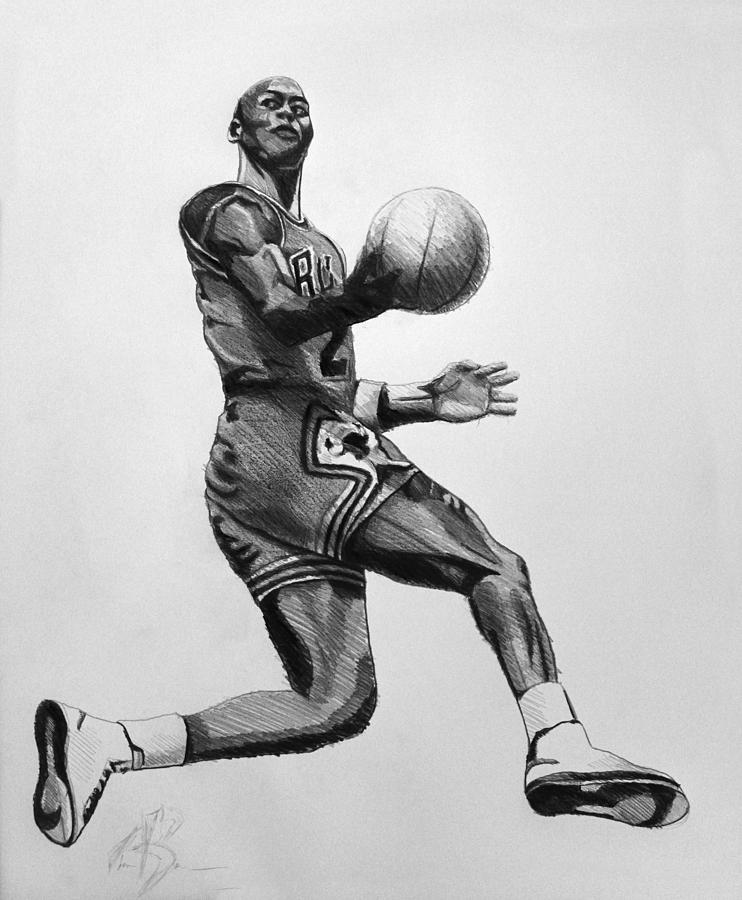 The lines that run along the field are called side lines, and those that are behind the baskets are called front lines.
The lines that run along the field are called side lines, and those that are behind the baskets are called front lines. - Central line. Divides the court in half parallel to the front lines.
- Central zone. It is a circle and is placed in the middle of the center line, and, accordingly, in the center of the entire field.
- Three-point line. It is a semi-ellipse and is located around the shields on both sides of the field. It limits the close range.
- Free throw line. It is located in front of the boards parallel to the front line and is limited on the sides by paint lines.
The standard line width is 5 cm. All outlines and lines must be of the same color (usually white) and be clearly visible from anywhere on the court.
Common lines
Common lines are used to limit the playing area of the court. The side lines (along the field) according to FIBA standards should be 28 m long, and the front lines - 16 m. For public areas, deviations from the accepted standards are allowed.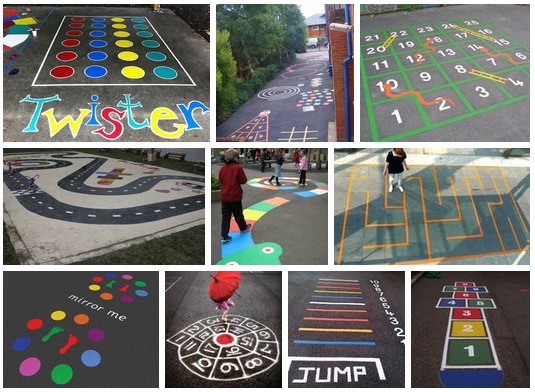 Typically, basketball courts in schools or gyms are made from 20 m long and 12 m wide.
Typically, basketball courts in schools or gyms are made from 20 m long and 12 m wide.
Central lines
The center line is parallel to the front and divides the field exactly in half. According to the standards - it should extend beyond the side lines by 15 cm on both sides.
In the middle of the center line there is a circle with a diameter of 3.6 m, which limits the central zone of the field. In this zone, the ball is played at the beginning of the game.
Three-Point Line
Three-Point Lines are located around the backboards on both sides of the field and consist of two straight lines 2.9 long9 m and a semicircle. Straight lines run perpendicular to the front at a distance of 0.9 m from the side lines. Despite the fact that visually the distance from the ring to the side of the three-point line seems to be less than to its central part, the distance from the backboard to any point is 6.75 m.
Penalty lines
Penalty lines limit the nearest area at the backboard.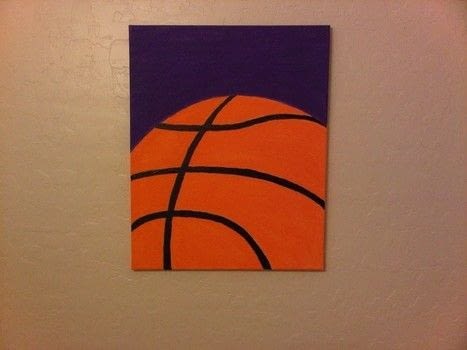 They consist of a trapezoid and a free throw zone.
They consist of a trapezoid and a free throw zone.
Despite the name, the "trapezium" is a rectangle (until 2009year it really was a trapezoid), which is located under the shield. Its dimensions are 5.8 meters long and 4.9 meters wide. The shield is located at a distance of 1.575 m from the end line in the middle of the site. In front of the backboard, at a distance of 1.25 m, there is a semicircle that limits the area for picking up the ball.
At a distance of 4.225 meters from the backboard, the trapeze zone ends and the free throw zone begins. It is a semicircle with a diameter of 3.6 m (like the central circle).
Paint zone lines
These lines are serifs on both sides of the trapezoid (parallel to the side lines). They limit the areas for players who are fighting for the ball during a free throw.
Zones on the basketball field
The basketball court is divided into zones using markings. Each zone has its own specific rules.
Center circle
The center circle is used as a separate kick-off area at the start of the game. One representative from each team stand in a circle from their side and fight for the ball in a jump, after it is dropped by the referee. All players are exclusively on their side of the field, except for one who rebounds on the opponent's side.
One representative from each team stand in a circle from their side and fight for the ball in a jump, after it is dropped by the referee. All players are exclusively on their side of the field, except for one who rebounds on the opponent's side.
Neutral zone
The peculiarity of this zone is that as soon as the player of the attacking team with the ball crosses the center line and is on the side of the opponent, he cannot pass the ball to the player of his team who is on the other side of the field (i.e. behind center line on your side).
Three-point zone
The three-point line limits the near zone of the shot. Hitting the basket from outside the basket brings the team three points. If the throw was made inside the zone, then it brings two points.
Three-second zone
This is the zone in close proximity to the ring. It is called three-second, since the player of the attacking team cannot be in it for more than three seconds. Most balls are thrown in this zone, so when attacking, it provides maximum protection.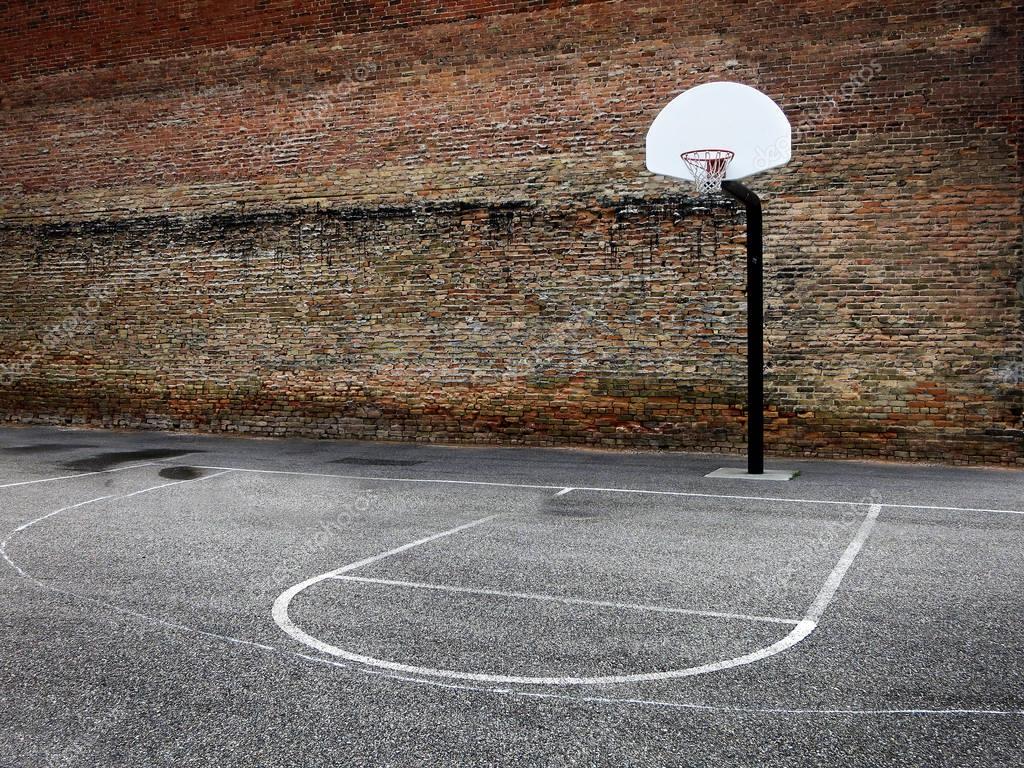
Free throw area
In controversial situations, a free throw is provided from this area. The player of the attacking team must score the ball without stepping over the line of the trapezoid. At the same time, the players of both teams are not in the three-second zone. They take up positions along the paint lines on the sides of the trapezoid and may not step outside the lines until the free throw shooter has shot the ball.
How to mark a basketball field?
Basketball field markings, whether it is an international competition court or an open-air amateur field, are best applied using special equipment. This will ensure the long life of the coating, the lines will not clog and will promote fair play.
You can order the marking of a basketball court in Moscow and the Moscow region from Rezkom. We will measure the premises and develop a design project for the field so that it complies with generally accepted rules and is convenient for operation. For more details, you can contact our manager by phone 8-495-64-24-111.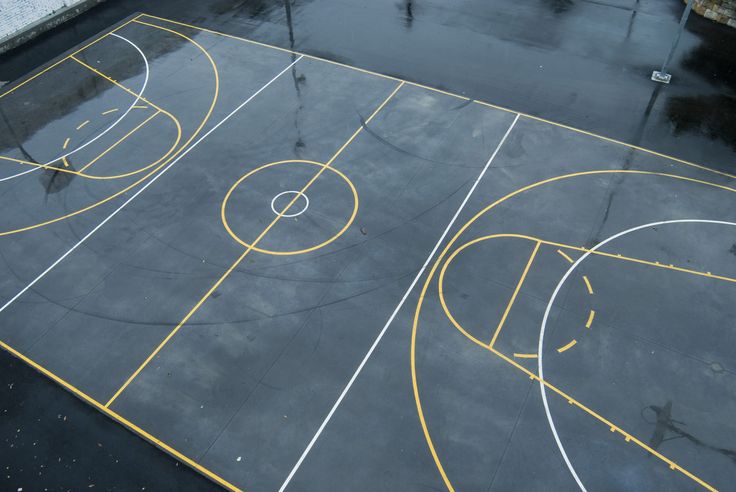
Construction of basketball courts. Basketball court in the yard
BASKETBALL AND STREET BALL GROUNDS
Basketball court is a rectangular playing field, limited by markings along the contour. The size of the court for international competitions, according to the International Basketball Federation (FIBA), is: length 28 meters, width 15 meters from the inner edge of the limit line.
Basketball court surfaces
More and more people in our country are beginning to get involved in sports, especially basketball and other team games that develop physical abilities and team spirit. However, in order to play basketball, you need a high-quality rubber coating for the basketball court. Otherwise, the game may result in injuries.
Construction of crumb rubber basketball court surfaces can be done outdoors or indoors. The rubber coating is resistant to all external influences and climatic conditions (temperature fluctuations, exposure to moisture, sunlight). In addition, it is durable, all-weather and wear-resistant.
In addition, it is durable, all-weather and wear-resistant.
Basketball court surfaces are different, each with qualities that are better suited to different sports and organizations.
Depending on performance, the basketball court can be built with artificial grass, acrylic and synthetic carpet, crumb rubber, parquet, etc.
Basketball rubber crumble is a 10mm thick single layer seamless synthetic turf used for team sports. Polyurethane coating is a black or colored crumb of a large fraction, which is mixed with a special binder during the work. It is laid with a special stacker on a specially prepared surface (concrete or asphalt).
Advantages of this coating:
- lack of seams on the surface, which makes it possible to make a flat surface without any protrusions and gaps;
- a permeable system that does not retain moisture inside, which prevents rot;
- synthetic composition prevents the life of insects inside the coating, which could destroy the structure of the coating and reduce the life of the coating;
- resistance to temperature changes from - 30°C to + 50°C, without compromising technical characteristics: does not fade, does not fade, does not break when freezing.
